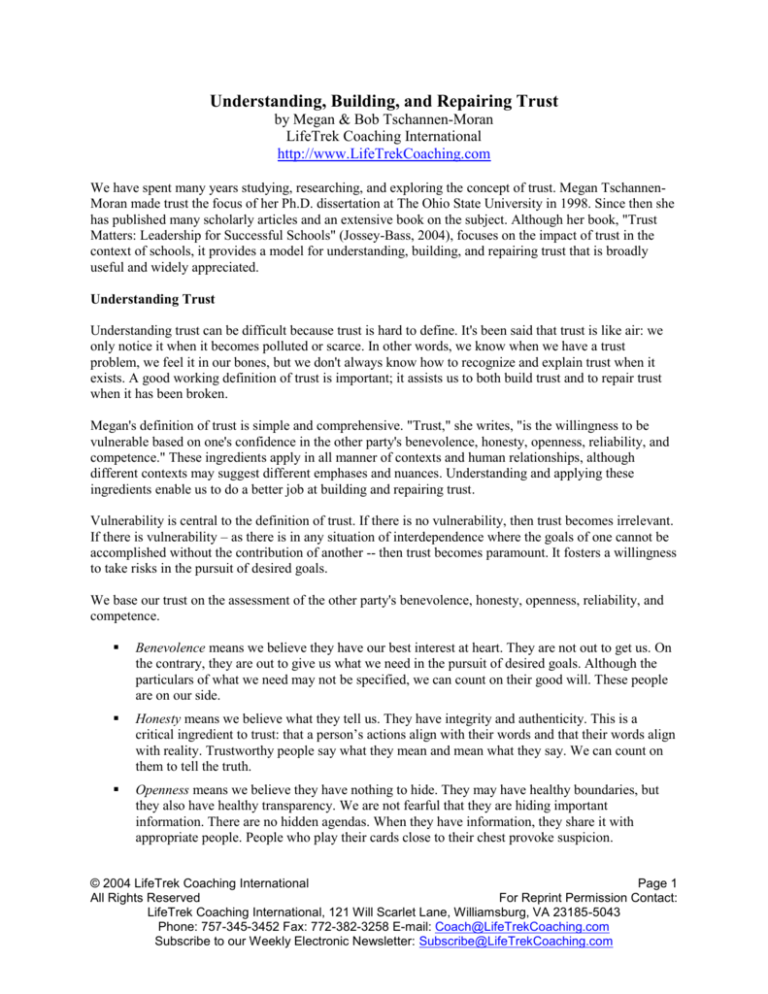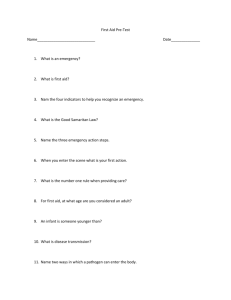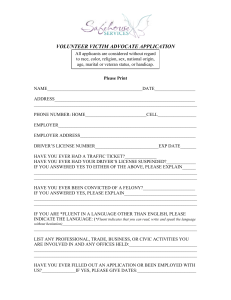
Understanding, Building, and Repairing Trust
by Megan & Bob Tschannen-Moran
LifeTrek Coaching International
http://www.LifeTrekCoaching.com
We have spent many years studying, researching, and exploring the concept of trust. Megan TschannenMoran made trust the focus of her Ph.D. dissertation at The Ohio State University in 1998. Since then she
has published many scholarly articles and an extensive book on the subject. Although her book, "Trust
Matters: Leadership for Successful Schools" (Jossey-Bass, 2004), focuses on the impact of trust in the
context of schools, it provides a model for understanding, building, and repairing trust that is broadly
useful and widely appreciated.
Understanding Trust
Understanding trust can be difficult because trust is hard to define. It's been said that trust is like air: we
only notice it when it becomes polluted or scarce. In other words, we know when we have a trust
problem, we feel it in our bones, but we don't always know how to recognize and explain trust when it
exists. A good working definition of trust is important; it assists us to both build trust and to repair trust
when it has been broken.
Megan's definition of trust is simple and comprehensive. "Trust," she writes, "is the willingness to be
vulnerable based on one's confidence in the other party's benevolence, honesty, openness, reliability, and
competence." These ingredients apply in all manner of contexts and human relationships, although
different contexts may suggest different emphases and nuances. Understanding and applying these
ingredients enable us to do a better job at building and repairing trust.
Vulnerability is central to the definition of trust. If there is no vulnerability, then trust becomes irrelevant.
If there is vulnerability – as there is in any situation of interdependence where the goals of one cannot be
accomplished without the contribution of another -- then trust becomes paramount. It fosters a willingness
to take risks in the pursuit of desired goals.
We base our trust on the assessment of the other party's benevolence, honesty, openness, reliability, and
competence.
Benevolence means we believe they have our best interest at heart. They are not out to get us. On
the contrary, they are out to give us what we need in the pursuit of desired goals. Although the
particulars of what we need may not be specified, we can count on their good will. These people
are on our side.
Honesty means we believe what they tell us. They have integrity and authenticity. This is a
critical ingredient to trust: that a person’s actions align with their words and that their words align
with reality. Trustworthy people say what they mean and mean what they say. We can count on
them to tell the truth.
Openness means we believe they have nothing to hide. They may have healthy boundaries, but
they also have healthy transparency. We are not fearful that they are hiding important
information. There are no hidden agendas. When they have information, they share it with
appropriate people. People who play their cards close to their chest provoke suspicion.
© 2004 LifeTrek Coaching International
Page 1
All Rights Reserved
For Reprint Permission Contact:
LifeTrek Coaching International, 121 Will Scarlet Lane, Williamsburg, VA 23185-5043
Phone: 757-345-3452 Fax: 772-382-3258 E-mail: Coach@LifeTrekCoaching.com
Subscribe to our Weekly Electronic Newsletter: Subscribe@LifeTrekCoaching.com
Reliability means we can count on people to do what they say they are going to do. They not only
talk the talk, they also walk the walk. Of course, some people can be reliably unreliable ("Oh,
she's always late"). But this does not inspire trust. Trust grows from positive reliability. We don't
have to invest energy making alternate plans in case they let us down.
Competence means we believe they can carry their weight. They have the right stuff, the right
knowledge and skills to provide for what is needed. They have not oversold their abilities for
personal gain.
When these five facets of trust are in place, trust functions paradoxically as both a lubricant and a glue. It
is a social lubricant in that it contributes to the smooth functioning of a relationship, family, group, or
organization. People do not have to expend energy monitoring the behavior and speculating on the
motivations of others; they can therefore invest their energy in better ways.
Trust is also the glue that can hold people together through good times and bad. Whether it's a couple or a
work team, trust binds people together through a commitment of caring. People not only care for what
needs to be done, they also care for the wellbeing of everyone involved.
Building Trust
If we hope to build trust with another person or in an organizational context, then it's important to practice
trustworthy behavior. That may appear obvious, but each word adds a critical dimension for building
trust.
Practice. Trustworthy behavior needs to become a practice and it also takes practice. We don't
just stumble upon trustworthy behavior. When we establish patterns, habits, rituals, and
conventions based upon our core values and overarching vision of life, those around us have the
opportunity to develop a deepening sense of trust over time. By consistently practicing
trustworthy behavior so that people feel they can predict our behavior, we both strengthen our
performance and win the confidence of others.
Trustworthy. Behavior that is worthy of trust balances a concern for what needs to get done (task)
with a concern for the people involved (relationship). It balances support and challenge. It avoids
micromanaging, ostensibly to improve quality. Being overly focused on controls, rules, and
procedures can actually undermine the development of trust. Trust gives people the room to make
and learn from their own mistakes. Honest self-appraisal of one's own benevolence, honesty,
openness, reliability, and competence can produce trust-enhancing, self-development action
plans.
Behavior. When it comes to building trust, actions speak much louder than words. Agreements
and understandings can, in fact, do more harm than good if they lead us to over promise and
under deliver. When this happens, we fall short in terms of both reliability and honesty. Better to
under promise and over deliver in order to make our behavior as consistent as possible with our
words.
Repairing Trust
Repairing trust is an arduous process, with no guarantee of success. Each party must perceive that the
short-term and/or long-term benefits to be derived from the relationship are highly valued enough to be
worth the investment of time and energy required to repair the damage. But if two parties seek to repair
© 2004 LifeTrek Coaching International
Page 2
All Rights Reserved
For Reprint Permission Contact:
LifeTrek Coaching International, 121 Will Scarlet Lane, Williamsburg, VA 23185-5043
Phone: 757-345-3452 Fax: 772-382-3258 E-mail: Coach@LifeTrekCoaching.com
Subscribe to our Weekly Electronic Newsletter: Subscribe@LifeTrekCoaching.com
trust, the five-facet model can point them in the right direction. The specific issues that have damaged
trust have to be identified and dealt with, agreements have to be made, and people have to renew their
commitment to practice trustworthy behavior over time.
Situations inevitably arise when something we care for is harmed, even if by accident. But when our
vulnerability is exploited out of selfishness or mean-spiritedness, we feel betrayed.
The nature of a trusting relationship can be altered instantaneously with a simple comment, a betrayed
confidence, or a decision that violates the sense of care one has expected of another. When a violation
occurs trust is often shattered, leaving distrust in its place.
The stage is set for betrayal when one party to a trusting relationship experiences sufficient dissatisfaction
with the current situation to begin to entertain alternatives that will expose the trust partner to potential
harm. Thus there is a drop in benevolence. The betrayer then seeks an alternative set of principles to
justify, at least to themselves, the proposed action. Thus there is a drop in integrity.
Fantasizing or planning a betrayal does not, in and of itself, constitute one. Action, even if the victim
never learns of it and even if no harm actually befalls them as a result, kicks off the cycle of betrayal. The
perpetrator is likely to want to hide what has happened from the victim in order to continue to reap
whatever goods they receive from the relationship. Thus there is a loss in openness. In an intimate
relationship, it is this lack of openness that can be most damaging to the relationship in the long run
because the perpetrator can never again be fully at ease, never again fully present to the victim. He or she
must always be on guard as long as the secret remains.
Learning of a betrayal can leave the victim feeling stunned and confused, and with a sense of unreality.
Upon reflection, those feelings turn to anger and the motivation to seek revenge. Revenge is not always a
bad thing. In the context of organizational life, revenge can act as a constraint against the abuse of power
and injustice. It can also be the act that settles the score, thereby opening the door to new possibilities for
the repair of trust.
More often than not, however, revenge sparks a downward spiral and a self-perpetuating cycle of feuding.
Until the victim of a betrayal is willing to confront their betrayer directly and negotiate new terms and
conditions for their relationship, repair of trust is unlikely. The violator can also make the repair of trust
impossible if he or she refuses to recognize and acknowledge that a violation has occurred.
The victim and the violator have different roles in the repair of trust. The victim speaks the truth of his or
her experience while the violator listens carefully and then engages sincerely in the "four A's of
absolution" – admit it, apologize, ask forgiveness, and amend your ways.
Admit It: To begin with, the violator acknowledges that a violation has occurred and that harm
was done. Listening carefully to the victim is a sign of respect and signals a willingness to engage
in a process of rebuilding the relationship. To dismiss the harm as insignificant is disrespectful to
the experience of the victim and the risk the victim may have experienced in arranging the
confrontation. The violator accepts responsibility for the effects of his or her actions. The violator
admits to having caused the event and also admits that it was destructive. Even if the harm was
unintentional, the violator needs to acknowledge that the way events unfolded and in the
experience of the victim, harm was done.
© 2004 LifeTrek Coaching International
Page 3
All Rights Reserved
For Reprint Permission Contact:
LifeTrek Coaching International, 121 Will Scarlet Lane, Williamsburg, VA 23185-5043
Phone: 757-345-3452 Fax: 772-382-3258 E-mail: Coach@LifeTrekCoaching.com
Subscribe to our Weekly Electronic Newsletter: Subscribe@LifeTrekCoaching.com
Apologize: To apologize is to not only admit that harm was done and that one’s actions
contributed to that harm, but to express regret for one's behavior. Trust is enhanced by a
willingness to apologize for the unpleasant consequences of one's actions. An apology can, in
some cases, be sufficient to restore the relationship because in admitting wrong there is an
implicit understanding that one wants to redeem himself or herself and will endeavor to avoid
repeating the error in the future. But the violator should not assume that the apology erases the
error for which it has been issued. To rush too readily to the conclusion that all is now well
violates the sense of care that undergirds the trusting relationship, and the sense that one will take
the needs and desires of the other seriously.
Ask Forgiveness: If trust is to be repaired, some form of forgiveness is required. Forgiveness can
be transformative, but it may not be easy to achieve. Forgiveness is a process in which the victim
reaches out to the betrayer and expresses a willingness to become vulnerable once again.
Forgiveness is not simply a state of mind; it is an action – or a sequence of actions – and a
ritualized undoing of the act of betrayal. Forgiveness can be facilitated when the violator makes
an explicit request to be forgiven. It's not enough to just start acting as if nothing ever happened
or nothing is wrong. Such implicit forgiveness is open to misinterpretation and may constitute an
offense in its own right. Forgiveness takes an explicit verbal act, saying some form of "I forgive
you" or "Forget It." It does not mean the offense is forgotten, but it does open the door for
repairing trust.
Amend Your Ways: It is the victim who determines what is required to restore trust. This often
entails specifying acts of reparation designed to demonstrate that the violator is sincere and
committed to rebuilding the relationship, including the willingness to incur a certain amount of
personal loss in doing so. The acts of reparation set by the victim may seem in the eyes of the
violator to be either reasonable or unreasonable, resulting in either a willingness or unwillingness
to meet them. If undertaken, the victim then has the opportunity to judge the sincerity and
commitment of the violator as he or she carries out these actions. Reparation also creates an
opportunity for the violator to work out any guilt that he or she may have over the harm that was
done, whether it was intentional or unintentional. Should the victim refuse to extend forgiveness
under any circumstances, continuing in an interdependent relationship is likely to be fraught with
tension, poor communication, and lower productivity.
Once the "four A's of absolution" have been negotiated, the reparations have been paid, and trustworthy
behavior has been practiced consistently over time, it becomes possible once again to reestablish an
atmosphere of trust. Good intentions are not enough. Through the steadfast demonstration of benevolence,
honesty, openness, reliability, and competence people become once again willing to make themselves
vulnerable.
© 2004 LifeTrek Coaching International
Page 4
All Rights Reserved
For Reprint Permission Contact:
LifeTrek Coaching International, 121 Will Scarlet Lane, Williamsburg, VA 23185-5043
Phone: 757-345-3452 Fax: 772-382-3258 E-mail: Coach@LifeTrekCoaching.com
Subscribe to our Weekly Electronic Newsletter: Subscribe@LifeTrekCoaching.com







